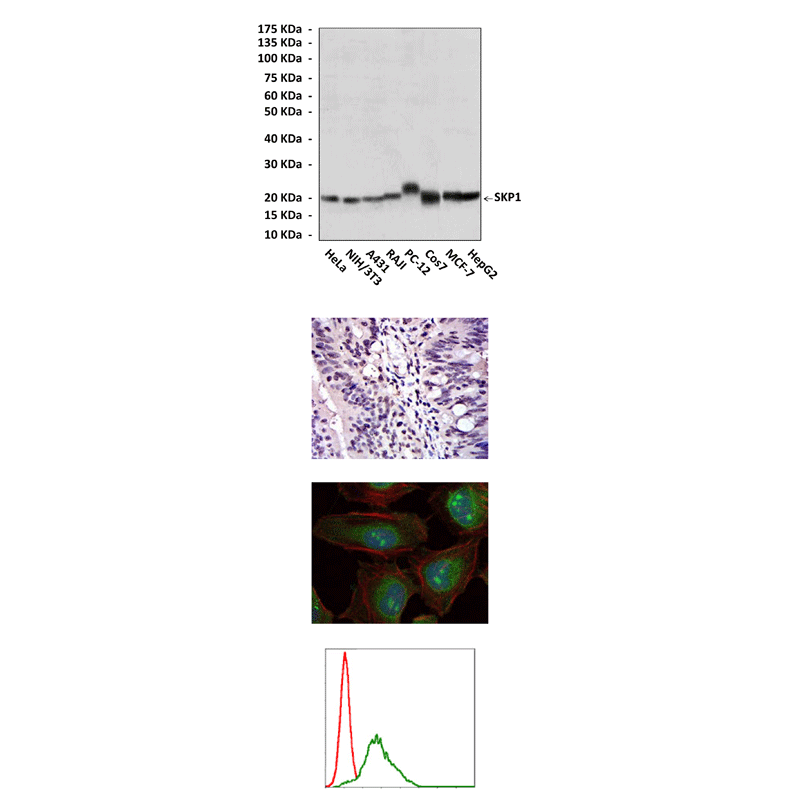Anti-SKP1: Mouse SKP1 Antibody
Mouse SKP1 Antibody: Mouse SKP1 Antibody
Size: 100 ul
Price: $457.00
Description
Skp1 (S-phase kinase-associated protein 1) is a core component of SCF ubiquitin ligases and mediates protein degradation, thereby regulating eukaryotic fundamental processes. SCF typically contain at least four subunits: Skp1, a cullin, a RING finger protein (Rbx1, also called Hrt1 or Roc1), and a member of the large family of F-box adaptor protein which acts as a receptor for target proteins and directly involved in the specific substrates recruitment. The F-box is a degenerated sequence of about 70 amino acids required but not sufficient for the interaction between a given F-box protein and Skp1. Skp1 is an adaptor between one of the variable F-box proteins and Cullin. Structure-function studies in yeast and mammals have demonstrated that the cullin functions as a scaffold in assembling the different subunits of the SCF complex. The cullin interacts at its carboxyl terminus with the RING domain protein Rbx1 to form the catalytic domain, and at its amino terminus end with Skp1. Ubiquitin is transferred from a ubiquitin-conjugating enzyme (E2) onto substrates recruited by the F-box protein. After poly-ubiquitination, the substrate is recognized by the proteasome and degraded. Protein degradation mediated by the SCF complexes has been shown to influence a variety of cellular processes such as the cell cycle, signal transduction and gene expression.2
There is only one known functional Skp1 protein in human and yeasts. Nevertheless, this unique protein is able to interact with different F-box proteins to ubiquinate different substrates. The human Skp1, for example, was originally identified as a protein that associates the cyclin A-CDK2 (cyclin-dependent kinase 2) complex with the F-box protein Skp2 and the SCFskp2 complex can ubiquitinate the p27Kip1 inhibitor of CDK, allowing CDK activity to drive cells into S phase. Another well-studied SCF complex in human, SCFFWD1, targets the NF-κB pathway and beta-catenin, a downstream signaling factor in the Wnt pathway of development and proliferation. Additionally, It has been demonstrated that Skp1 plays a critical role in the preservation of genetic stability. Inhibition of Skp1 functions in cells lead to caused the formation of multinucleated cells, defects in centrosomes and mitotic spindles, impaired chromosome segregation, and chromosomal instability and also resulted in neoplastic transformation with high penetrance.3 Beside the canonical SCF, it appears that in some cases, Skp1 and F-box proteins may function in non-SCF complexes and that some F-box proteins have functions on their own. Studies have also characterized Skp1 as an RNA polymerase II elongation factor.4
2. Zheng, N. et al: Nature 416:703-9, 2002
3. Piva, R. et al: Mol. Cell. Biol. 22: 8375-87, 2002
4. Conaway, R.C. et al: Science 296:1254-8, 2002
Details
| Cat.No.: | CP10434 |
| Antigen: | Raised against recombinant human SKP1 fragments expressed in E. coli. |
| Isotype: | Mouse IgG1 |
| Species & predicted species cross- reactivity ( ): | Human, Mouse, Rat |
| Applications & Suggested starting dilutions:* | WB 1:1000 IP 1:50 – 1:100 IHC 1:50 – 1:200 ICC 1:50 – 1:200 FACS 1:50 – 1:200 |
| Predicted Molecular Weight of protein: | 19 kDa |
| Specificity/Sensitivity: | Detects SKP1 proteins in various cell lysate. |
| Storage: | Store at -20°C, 4°C for frequent use. Avoid repeated freeze-thaw cycles. |
*Optimal working dilutions must be determined by end user.
